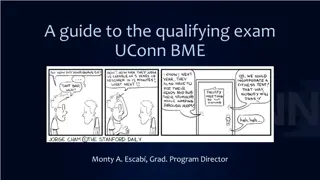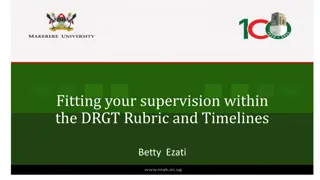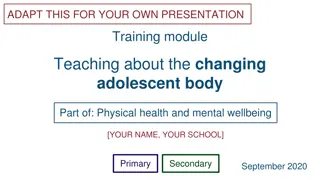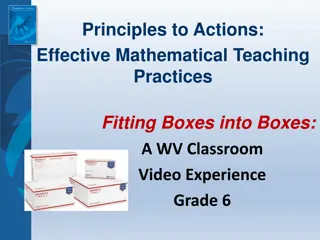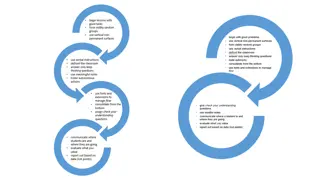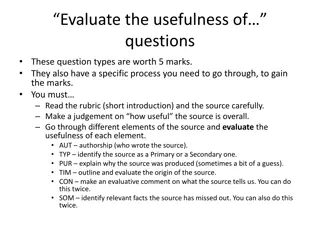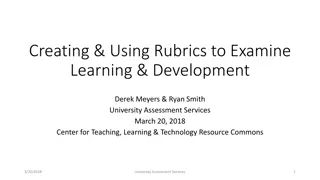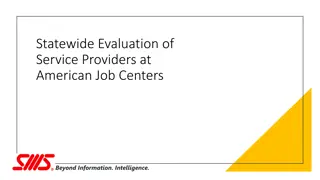Best Practices for Rubric Design in Teaching
Explore the key components of rubrics, understand their importance in assessment, and learn how to effectively design and use them to enhance student learning outcomes.
Download Presentation

Please find below an Image/Link to download the presentation.
The content on the website is provided AS IS for your information and personal use only. It may not be sold, licensed, or shared on other websites without obtaining consent from the author. Download presentation by click this link. If you encounter any issues during the download, it is possible that the publisher has removed the file from their server.
E N D
Presentation Transcript
Best Practices for Rubric Design Susan Gallanis, Center for Excellence in Learning and Teaching (CELT) 1
Objectives 2 Introduce the four main components of a rubric Compare two general rubric types Analyze rubric examples Emphasize best practices for rubric design
What is a Rubric? 3 Assessment tool Clearly indicates achievement criteria Addresses all components of student work Written Assignments Presentations Class participation Online discussion
Why use Rubrics? 4 Conveys expectations Provides timely feedback Provides consistent feedback and allows for additional, individual feedback Can save time grading Easy to see if student work is improving over time and what area is improving
Rubric Components 5 Title Description (if for a specific assignment) Scale (levels of achievement) Usually spans across the top beneath task description Describes overall how well or poorly a task was performed Dimensions (criteria) Usually spans down the left side Categories of what will be graded Description of the dimensions ( the boxes ) Descriptions of student performance should be on a continuum across the scale (best practice)
Generic 3 5 Level Rubric 6 Title or Task Description: Scale: Lowest Scale: Low Scale: Middle Scale: High Scale: Highest Dimension 1 Description Description Description Description Description Dimension 2 Description Description Description Description Description Dimension 3 Description Description Description Description Description
Example 7
More about Scales 8 Is there a best practice scale? No Logical, clear, tactful Examples Mastery, partial mastery, progressing, emerging High level, middle level, beginning level Exemplary, proficient, marginal, unacceptable Accomplished, average, developing, beginning A, B, C, D, F Concordia University Standard Scale (SBE, BE, ME, EE, SEE) Include a scoring strategy does is reflect grading scale on syllabus?
Scoring Strategy Example 9 Excellent (4 points) Average (2-3 points) Developing (0-1 point) Dimension 1 Dimension 2 Dimension 3 Dimension 4 16 points (100%) 8 12 points (50 75%) 0 4 points (0 25%)
More about Dimensions and Descriptions 11 Dimensions (Criteria) Lay out parts of the task simply and clearly Categories of performance Do not include description of the quality of performance Each dimension may or may not be weighted (previous slide had weighted dimensions) Description of dimensions: At minimum, description of each dimension is provided at the highest level of performance (a scoring rubric) Descriptions across the scale should be logical and follow a continuum. (Good example on slide 7)
Example: 3-level Rubric 12 Proficient Student demonstrates they have seriously reflected and interpreted unit content and able to apply it. Answered prompts with original thought and critical thinking. Competent Student demonstrates some original thought and basic understanding of unit content. Novice Student does not demonstrate understanding of unit content and suggests that the unit content was not read carefully. Content and connection to course objectives (Dimension doesn t reflect the description?) Meaningful Reflection Student shares their interpretation and understanding of unit content/themes and supports their ideas with facts and examples of application. References cited. Student shares their interpretation and understanding of unit content/themes and supports their ideas with personal opinion without supporting evidence. Student provides little to no personal insight on the unit content/themes and does not offer evidence to support their point of view. Voice, organization, and engagement Student responds to discussion instructions with details as well as instructor prompts. Responds to more than the required peer comments and shares ideas that advance the discussion. Student partially responds to discussion instructions, instructor prompts. Participates minimally with peer posts and summarizes what has already been stated without adding to the discussion. Student s submission does not follow discussion instructions, instructor prompts and fails to engage with peers. Grammar, Spelling, and Mechanics Written clearly, no spelling, punctuation and grammar errors. APA guidelines followed. There are 1-3 writing errors and/or APA guidelines not followed. There are 4+ writing errors and/or references not cited using APA guidelines.
Recap: Two Types of rubrics 13 3 5 Level Rubric what we ve looked at so far (recommended) Description of dimensions with all levels of performance described Descriptions should have a logical flow across the levels of performance Avoid overlap of descriptions between dimensions Take longer to create (written feedback is part of rubric) Faster to grade Scoring Rubric/Guide Description of dimensions is at the highest level of performance May be best used for yes/no dimensions. Faster to create May take longer to grade if providing narrative feedback
When Designing a Rubric: 16 What knowledge and skills is the assignment designed to assess? (Learning Objective) What observable criteria represent those knowledge and skills (Performance Criteria/Dimensions) How can you best divide those criteria to represent distinct and meaningful levels of student performance? (Performance Levels/Scale) What observable characteristics of students work differentiate among the performance levels for each criterion? (Descriptions/ the boxes ).
Blackboard Rubrics 17 Can save to PDF for posting to Blackboard (conveys expectations) CELT provides training, resources How to create How to attach to Blackboard Assignment How to grade How to copy to another course Recommend percentage-range rubric
Additional Resources 18 Using Rubrics (Cornell University Center for Teaching Innovation) Rubrics: Useful Assessment Tools (University of Waterloo) VALUE Rubrics (American Association of Colleges and Universities) Stevens, D. D., & Levi, A. (2013). Introduction to rubrics: An assessment tool to save grading time, convey effective feedback, and promote student learning (2nd ed.). Sterling, VA: Stylus. Best Practices for Designing Effective Rubrics (Arizona State University)


























